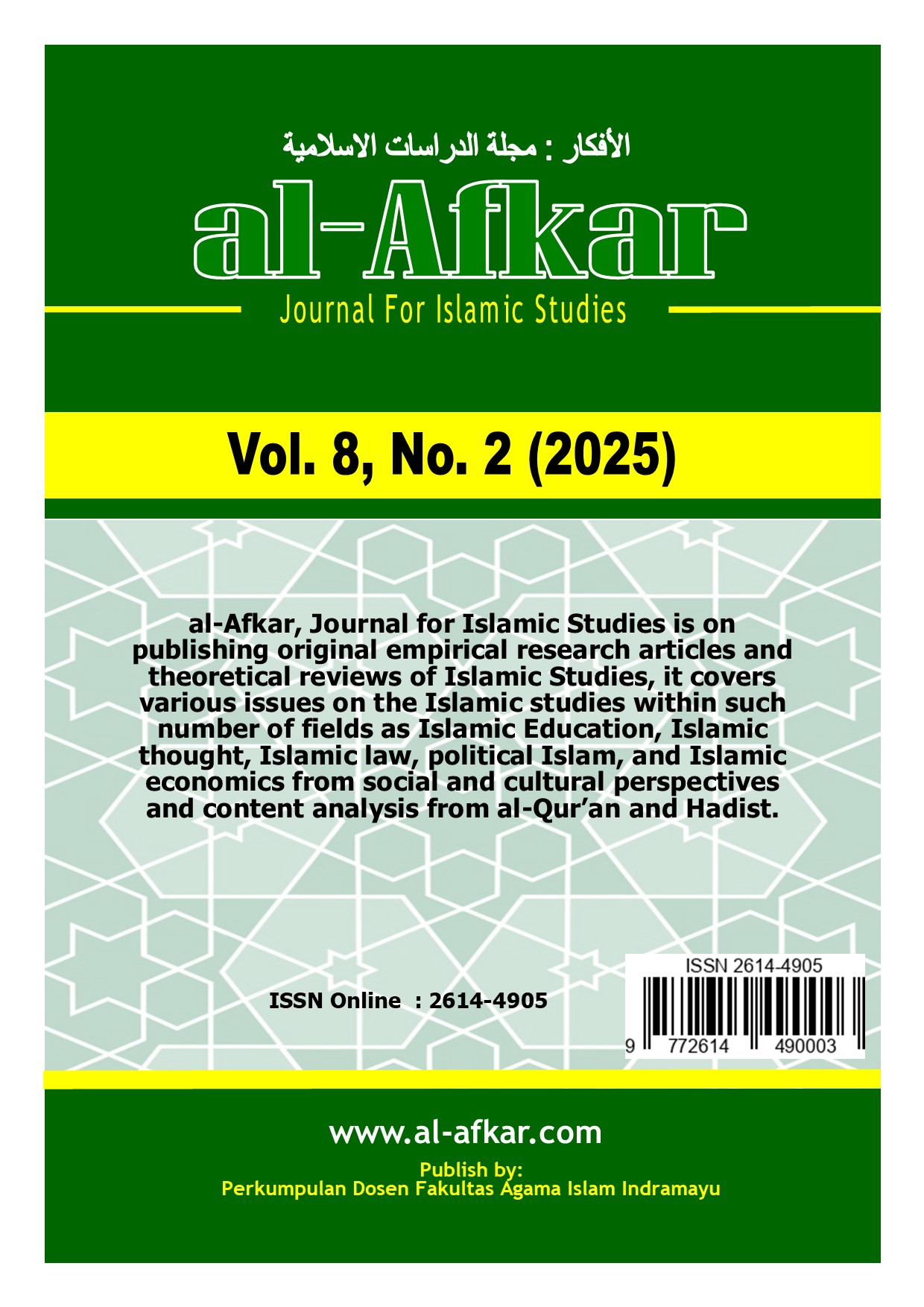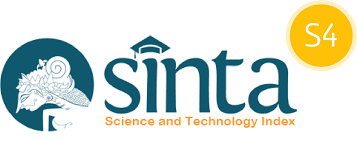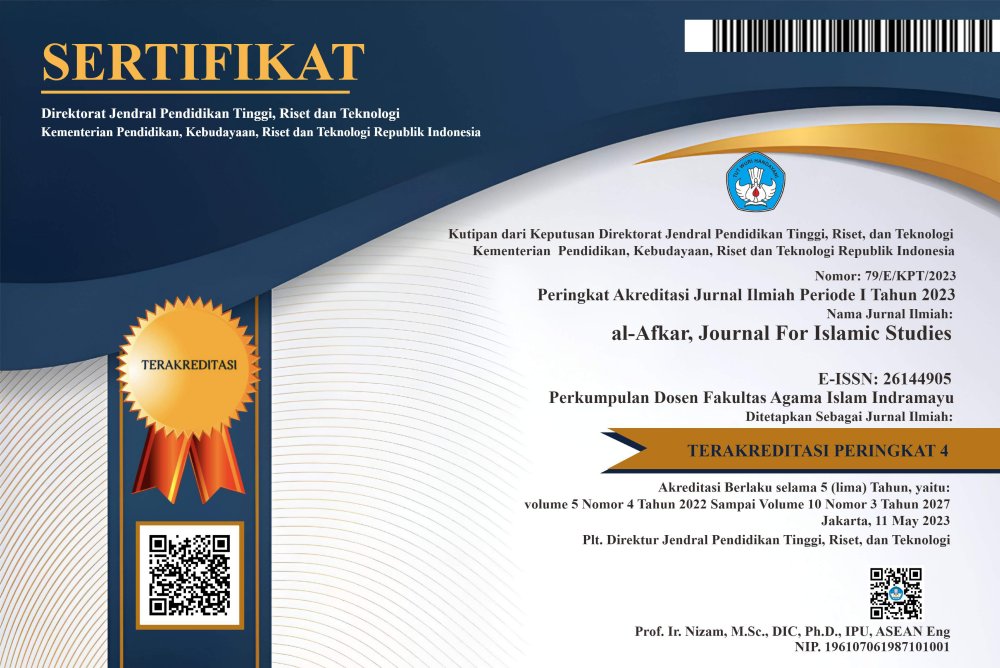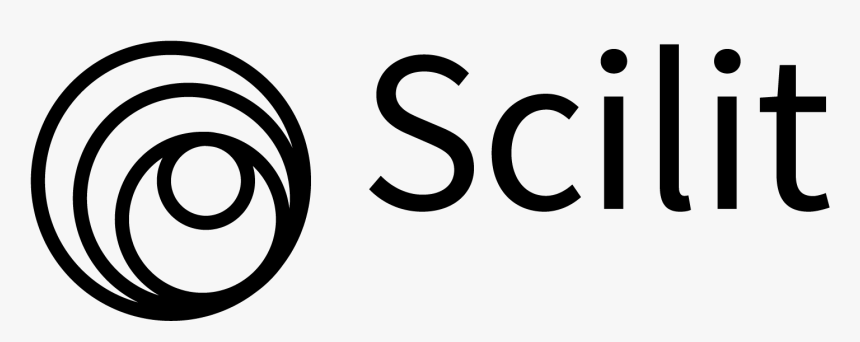The Characteristics of Shalihah Woman in the Qur’an: Quraish Shihab’s Perspective in Tafsir Al-Mishbah
DOI:
https://doi.org/10.31943/afkarjournal.v8i2.1381Keywords:
Characteristics, Shalihah Women, Holy Qur'an, Quraish Shihab, Tafsir Al-MishbahAbstract
The study of the characteristics of shalihah women is very important to study. Islam positions women as very noble, valuable and dignified creatures. Shalihah women have a big impact, especially in educating and forming the next generation. A mother has an important role in guiding and educating her children. So if the mother is good, it is likely that her children will also grow up to be good individuals. This makes an extraordinary contribution to the formation of a better and civilized society. The research uses qualitative research and Library Research as type of the research. Primary data sources were taken from Tafsir Al-Mishbah and secondary data from books, journals and related articles. Data analysis in this study used descriptive-deductive. The researcher will describe the verses that related to the characteristics of shalihah women in the Qur'an in general and then specifically based on the Quraish Shihab’s perspective in Tafsir Al-Mishbah. The aim of this research is to determine the characteristics of pious women in the Qur'an based on the Quraish Shihab’s perspective in Tafsir Al-Mishbah. The results of this research are the importance of moral perfection, piety, obedience and loyalty to the teachings of the Islamic religion. Specifically are covering one's private parts properly, including holding up the hijab, obeying Allah and her husband, maintaining chastity and honor, guarding one's genitals, patience, khusyu' and qunut, which includes all types of obligatory and sunnah obedience.
Downloads
References
al- Mubarakfuri, Syaikh Shafiyyurrahman. Shahih Tafsir Ibnu Katsir Jilid 6. Jakarta: Pustaka Ibnu Katsir, 2017.
Alkampari, H H, A F Rizki, and D Marzal. “Pendapat Quraish Shihab Dalam Tafsir Al Mishbah Tentang Berbuat Ihsan Dalam Dimensi Sosial.” Al-Fikra: Jurnal Ilmiah Keislaman 20, no. 2 (2021).
Amrullah, Haji Abdulmalik Abdulkarim. Tafsir Al-Azhar Jilid 2. Singapura: Pustaka Nasional PTE LTD, 2007.
As-Suyuthi, Imam. Asbabun Nuzul Sebab-Sebab Turunnya Ayat. Jakarta: Pustaka Al-Kautsar, 2015.
Cahyono, Aris Dwi. “(Library Reserch) Peranan Pengembangan Manajemen Kinerja Tenaga Administrasi Kesehatan Terhadap Peningkatan Mutu Pelayanan Kesehatan Di Puskesmas.” Jurnal Ilmiah Pemeneng - JIP 3, no. 2 (2021): 28–42.
Dewianti, Annisa Fitri, Farhah Desrianty Gimri, Elsa Marfina Nandiani, Bambang Ardiansyah, and Wismanto. “Analisis Urgensi Pendidikan Akhlak Berkarakter Dalam Membangun Keluarga Bahagia,” no. 3 (2024).
Hamka. Tafsir Al-Azhar Jilid 10. Singapura: Pustaka Nasional PTE LTD, 2007.
———. Tafsir Al-Azhar Jilid 9. Singapura: Pustaka Nasional PTE LTD, 2007.
Hidayati, Widiani. “Nilai-Nilai Pendidikan Akhlak Wanita Dari Pada Istri Nabi (Analisis Surat Al-Ahzab Ayat 28-35 Dalam Kitab Tafsir Al- Azhar Karya Buya Hamka).” El-Tarbawi 14, no. 2 (2021): 196. https://doi.org/10.20885/tarbawi.vol12.iss2.art4.
Jannah, Miftahul. “Korelasi Antara Wanita, Perhiasan, Dan Aurat Dalam Al-Qur’an Surah An-Nur Ayat 31 Menurut Prespektif Mufassir Nusantara.” ANWARUL Jurnal Pendidikan Dan Dakwah 4, no. 1 (2024): 42–66.
Khotimah, Husnul, Rizka Nanda Utari, Sherin Naura Efendi, Dwi Ananda, and Elsa Marfina Nandiani. “Kedudukan Perempuan Dalam Pandangan Islam.” EDUKASI Jurnal Pendidikan Dan Keguruan 4, no. 1 (2024).
Masruroh, Elliyatul. “Karakteristik Wanita Salihah Dalam Al-Qur’an (Studi Komparatif Tafsir Al-Sha’rawi Karya Syaikh Mutawalli Al-Sha’rawi Dan Tafsir Firdaus Al-Na’im Karya Kyai Thaifur Ali Wafa).” EL-WAROQOH Jurnal Ushuluddin Dan Filsafat 6, no. 2 (2022).
Mauludah, Anis Zulfiah, Toha Ma’sum, and Juni Iswanto. “Konsep Kepemimpinan Pendidikan Islam Perspektif Muhammad Quraish Shihab Dalam Tafsir Al-Mishbah.” JIIP - Jurnal Ilmiah Ilmu Pendidikan 6, no. 11 (2023): 9495–9501. https://doi.org/10.54371/jiip.v6i11.2594.
Nurhayati, Is. “Pendidikan Akhlak Dalam Berpakaian Bagi Perempuan Menurut Surat An-Nur Ayat 31 Dan Al-Ahzab Ayat 59.” THORIQOTUNA: Jurnal Pendidikan Islam 3, no. 1 (2020): 14.
Padrian, Muh. “Kriteria Perempuan Shalihah Perspektif Buya Hamka Dalam Tafsir Al-Azhar,” 2023.
Radella, Sayyidah Balqis, and Fejrian Yazdajird Iwanebel. “Mengurai Narasi Gender Dalam Al-Jami’ Li Ahkam Al-Qur’an Karya Al-Qurtubi: Dari Dominasi Laki-Laki Hingga Upaya Penghargaan Perempuan” 1, no. 2 (2023): 256–72.
Sari, Milya. “Penelitian Kepustakaan (Library Research) Dalam Penelitian Pendidikan IPA.” Natural Science: Jurnal Penelitian Bidang IPA Dan Pendidikan IPA 6, no. 1 (2020): 41–53.
Shihab, M. Quraish. Tafsir Al-Misbah Kesan Dan Keserasian Al-Qur’an Volume 14. Tafsir Al-Mishbah. Vol. 14. Tangerang: Penerbit Lentera Hati, 2006. https://ia803106.us.archive.org/22/items/etaoin/Tafsir Al-Mishbah Jilid 14 -Dr. M. Quraish Shihab.pdf.
———. Tafsir Al-Mishbah Pesan, Kesan Dan Keserasisan Al-Qur’an Volume 11. Cetakan IV. Jakarta: Lentera Hati, 2005.
Susanto, Wiji. “Konsep Wanita Shalihah Dalam Kisah Istri Fir’aun (Analisis Al-Qur’an Surat At-Tahrim Ayat 11)”.” Ilmuna 1, no. 1 (2019): 113–38.
Yuwanti, Bening, Sulaiman Muhammad Amir, and Winda Sari. “Makna ‘Tafakhur’ Dan ‘Takatsur’ Dalam Al Qur’an Dan Relevansinya Dengan Gaya Hidup Hedonisme (Analisis Penafsiran Buya Hamka Dan Quraish Shihab Terhadap Q.S. Al Hadid Ayat 20 Dalam Tafsir Al Azhar Dan Al Misbah).” Asian Journal of Islamic Studies and Da’wah 2, no. 1 (2023): 70–86. https://doi.org/10.58578/ajisd.v2i1.2425.
Downloads
Published
How to Cite
Issue
Section
License
Copyright (c) 2025 Shery Fara Afifah, Nasrulloh

This work is licensed under a Creative Commons Attribution 4.0 International License.



















